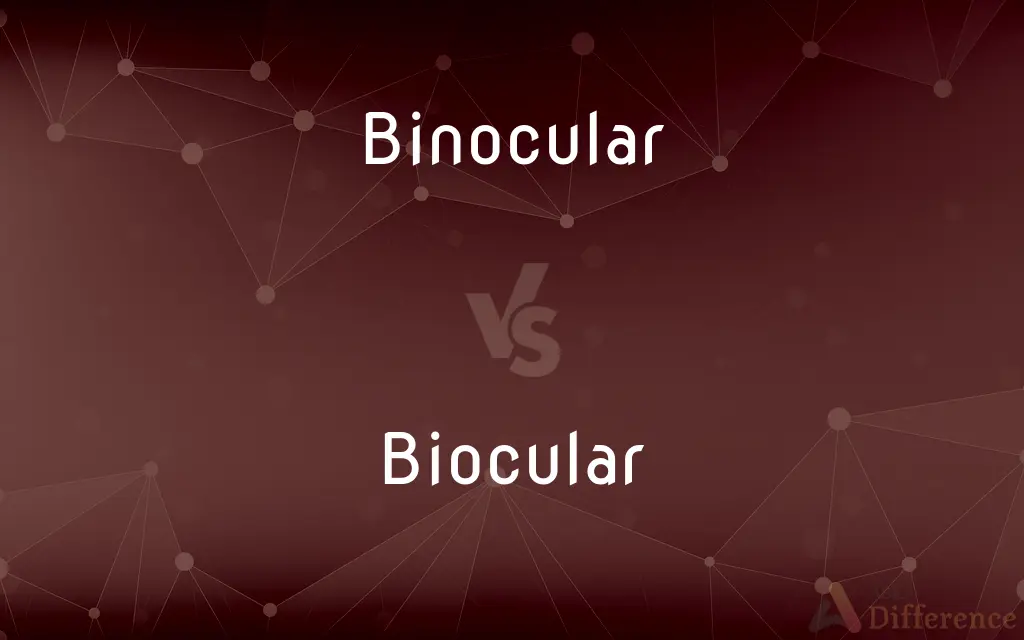Binocular vs. Biocular — What's the Difference?
By Urooj Arif & Maham Liaqat — Updated on March 31, 2024
Binocular refers to devices or vision involving both eyes, enhancing depth perception, while biocular implies the use of both eyes but through a single optical channel or eyepiece.

Difference Between Binocular and Biocular
Table of Contents
ADVERTISEMENT
Key Differences
Binocular devices, like binoculars or binocular microscopes, are designed for use with both eyes, providing two separate optical channels that simulate natural human vision. This design enhances depth perception and offers a three-dimensional view by allowing each eye to receive a slightly different image, mimicking the way human vision perceives depth. On the other hand, biocular devices, though intended for use with both eyes, utilize a single optical channel that is split into two viewing ports, offering the same image to both eyes.
While binocular vision and devices cater to a natural, immersive viewing experience crucial for activities requiring depth judgment, such as bird watching, hunting, or certain sports, biocular devices are often used in situations where depth perception is less critical, but binocular viewing is still desired for comfort or for the viewing of distant objects. Examples include certain types of night vision goggles or budget-friendly telescopes, where manufacturing a true binocular system might be cost-prohibitive.
The difference in the optical paths of binocular and biocular devices also impacts their design and complexity. Binocular devices tend to be more complex and potentially more expensive due to the need for two distinct optical paths and alignment mechanisms ensuring that the two images merge correctly for the viewer. In contrast, biocular devices can be simpler and more cost-effective, as they require only one set of optics, reducing the complexity and cost of production.
The choice between binocular and biocular devices is often dictated by the specific needs of the user, including considerations like the importance of depth perception, the intended use of the device, and budget constraints. While professionals or enthusiasts in fields requiring precise depth cues might prefer binocular devices, casual users or those needing devices for simple observation might find biocular options sufficiently effective.
Despite the differences in design and functionality, both binocular and biocular devices play important roles in various fields and hobbies, offering enhanced visual experiences compared to monocular viewing. Whether for scientific research, recreational use, or tactical applications, the choice between binocular and biocular depends on the balance between the need for depth perception, cost, and the specific viewing requirements of the task at hand.
ADVERTISEMENT
Comparison Chart
Optical Channels
Two separate channels for each eye.
A single optical channel split into two viewing ports.
Depth Perception
Enhances depth perception by providing different images to each eye.
Does not enhance depth perception; the same image is presented to both eyes.
Design Complexity
More complex due to the need for aligning two optical paths.
Simpler, with a single set of optics.
Cost
Generally more expensive due to complexity.
Can be more cost-effective due to simpler design.
Use Cases
Preferred in activities where depth judgment is crucial, like bird watching or sports.
Used when depth perception is less critical but binocular viewing is desired for comfort.
Image View
Three-dimensional view.
Two-dimensional view, similar to monocular vision.
Compare with Definitions
Binocular
A device, such as binoculars, designed for use with both eyes to observe distant objects, providing a 3D image.
He used his binoculars to watch birds at the lake.
Biocular
Designed for use with both eyes but through a single optical channel.
The biocular night vision device was lighter and less expensive than traditional binocular models.
Binocular
Enhances the viewer's depth perception and field of view.
Binocular microscopes are essential for detailed scientific observations.
Biocular
Offers a comfortable viewing experience without enhancing depth perception.
For long surveillance periods, the biocular setup reduced eye strain.
Binocular
Pertaining to or involving both eyes.
Binocular vision allows for accurate depth perception.
Biocular
Can be a more cost-effective solution for certain applications.
Tourists often use biocular telescopes at scenic overlooks for a clear, stable view.
Binocular
Relating to, used by, or involving both eyes at the same time:binocular vision.
Biocular
(of an optical system) In which the optical components are shared by both of the viewer's eyes.
Binocular
Having two eyes arranged to produce stereoscopic vision.
Binocular
OftenbinocularsAn optical device, such as a pair of field glasses or opera glasses, designed for simultaneous use by both eyes and consisting of two small telescopes joined together.
Binocular
Using two eyes or viewpoints; especially, using two eyes or viewpoints to ascertain distance.
A binocular microscope or telescope
Binocular
Attributive form of binoculars
Binocular
A pair of binoculars.
Binocular
(dated) Any binocular glass, such as an opera glass, telescope, or microscope.
Binocular
Having two eyes.
Binocular
Pertaining to both eyes; employing both eyes at once; as, binocular vision.
Binocular
Adapted to the use of both eyes; as, a binocular microscope or telescope.
Binocular
A binocular glass, whether opera glass, telescope, or microscope.
Binocular
An optical instrument designed for simultaneous use by both eyes
Binocular
Relating to both eyes;
Binocular vision
Common Curiosities
How do biocular devices work?
Biocular devices work by splitting the image from a single optical channel into two viewing ports, presenting the same image to both eyes.
Why would someone choose a binocular device?
For activities requiring depth perception and a wide field of view, binocular devices are preferred for their ability to provide a three-dimensional viewing experience.
What makes a device binocular?
A binocular device has two separate optical channels, allowing each eye to receive a unique image, mimicking natural human vision.
Can biocular devices be used for bird watching?
While biocular devices can be used for bird watching, binocular devices are generally preferred for this activity due to their superior depth perception and three-dimensional views.
Can biocular devices reduce eye strain?
Yes, by allowing the use of both eyes in a more natural position, biocular devices can reduce eye strain compared to monocular viewing, especially over long periods.
Do professionals use biocular devices?
Yes, professionals in various fields may use biocular devices when the advantages of a binocular setup (less eye strain, comfort) are desired without the necessity for enhanced depth perception.
How do binocular and biocular devices differ in their impact on visual comfort?
Binocular devices can offer a more natural and comfortable viewing experience by providing images to each eye as they would naturally receive them. Biocular devices also offer comfort by allowing the use of both eyes but may lack the fully immersive experience of binocular vision.
Are biocular devices bad for observing distant objects?
No, biocular devices can be quite effective for observing distant objects, especially in situations where depth perception is not a primary concern.
Is there a significant price difference between binocular and biocular devices?
Yes, binocular devices tend to be more expensive due to their more complex design and the need for precise alignment of optical paths.
What are the main advantages of binocular devices over monocular ones?
The main advantages include enhanced depth perception, a wider field of view, and a more immersive viewing experience by mimicking natural human vision.
What are some common misconceptions about biocular and binocular devices?
A common misconception is that biocular devices offer the same depth perception as binocular devices, when in fact they do not. Another misconception is that binocular devices are always superior, which isn’t true for every application or user preference.
How does the design of binocular and biocular devices influence their durability and maintenance?
Binocular devices, due to their complexity and alignment mechanisms, may require more careful maintenance and can be more susceptible to damage if dropped or mishandled. Biocular devices, being simpler in design, might be more robust and easier to maintain, though this can vary widely depending on the specific model and build quality.
Can the use of biocular devices affect depth perception?
Yes, because biocular devices provide the same image to both eyes without the slight differences characteristic of binocular vision, they do not enhance depth perception in the way binocular devices do.
In what situations might a biocular device be preferred over a binocular one?
Biocular devices might be preferred in situations where depth perception is less critical, but the comfort of using both eyes is desired, such as in certain types of surveillance, casual stargazing, or when budget constraints make them a more viable option.
Are there specific fields or hobbies where binocular devices are considered essential?
Yes, fields such as ornithology (bird watching), astronomy, sports like hunting or archery, and any profession or hobby that requires precise depth judgment and a wide field of view often consider binocular devices essential.
Share Your Discovery

Previous Comparison
Ionize vs. Unionized
Next Comparison
Compute vs. CalculateAuthor Spotlight
Written by
Urooj ArifUrooj is a skilled content writer at Ask Difference, known for her exceptional ability to simplify complex topics into engaging and informative content. With a passion for research and a flair for clear, concise writing, she consistently delivers articles that resonate with our diverse audience.
Co-written by
Maham Liaqat















































